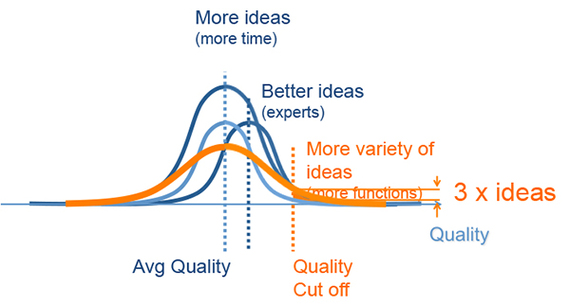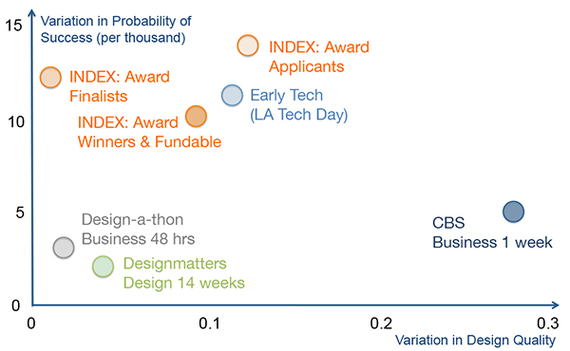New Entrepreneurial Ventures are all about speed and nowhere is this more true than at design-a-thons. Originating from hack-a-thons in the world of programming, design-a-thons are a one, two or three day marathon, where participating teams build a Minimal Viable Product (MVP) or, at the very least, a concept simulation supported by a business model and some validation. Outcomes are presented to a panel of judges at the end who then award prizes to the winner. So, might design-a-thons be a superior approach to generating new business opportunities?
A weekend design-a-thon held recently in Pasadena, CA, provided an opportunity to study how teams perform in a confined, high stress environment. We found that design-a-thons generate concepts somewhat lower in design Quality (as measured by a composite Design Index) and somewhat riskier as compared to regular new entrepreneurial ventures.
This, somewhat lower performance, is to be expected, since design-a-thon participants have not yet had the time or human, social or financial resources to refine and detail their business model and concept. In short it is still a seed of a business. The question then becomes, will the team be able to learn and pivot, or, blinded by their initial success, pigheadedly forge ahead and become un-trainable?
Comparing the quality of the design-a-thon outcome to alternative approaches, such as a one-week workshop and a fourteen-week semester, - revealed that design-a-thons produce higher quality performance than a semester, however lower quality than one-week of concentrated work. Perhaps a concentrated week provides a better balance between focus and incubation when it comes to design development.
Comparing risk-reduction, design-a-thons produce less risky ventures than one week workshops, although more risky ventures than that of a full semester course. However, when looking at the Design Quality - Probability of Success tradeoff, they all perform on par, indicating that time on task does not really influence risk reduction at all.
Average Design Quality and risk position are only two of the performance metrics that are important for a successful outcome of competitive contests. Of course quantity matters, so the more contestants there are the more potential ventures will emerge from the competition. However, variation in Design Quality and risk position matters as well.
A surprising insight was the relatively low variation in Design Index and Possibility of Success for the outcomes of design-a-thons. Here, one-week workshops again outperformed full semester courses, as well as, design-a-thons. This may be due to a herding effect since in design-a-thons participants work, eat and sleep shoulder to shoulder and therefore, are constantly aware of where the bar is set.
With semester courses the same alignment may happen, so one-week courses may offer a good balance in providing enough space to create a larger variation in ideas and a sufficiently short period to prevent streamlining of venture ideas over time.
Finally, throwing a wider net increases not just performance but also variety. INDEX: Award applicants, finalists, as well as, winners and fundable ventures performed better over all. The selection process guarantees that more high quality ventures are identified.
So, when next contemplating a competition to generate new ideas for ventures, it may be advantageous to invite participants from across the globe, keep them separated and spread those precious hours over a week instead of cramming them into a weekend complete with high stress all nighters.


